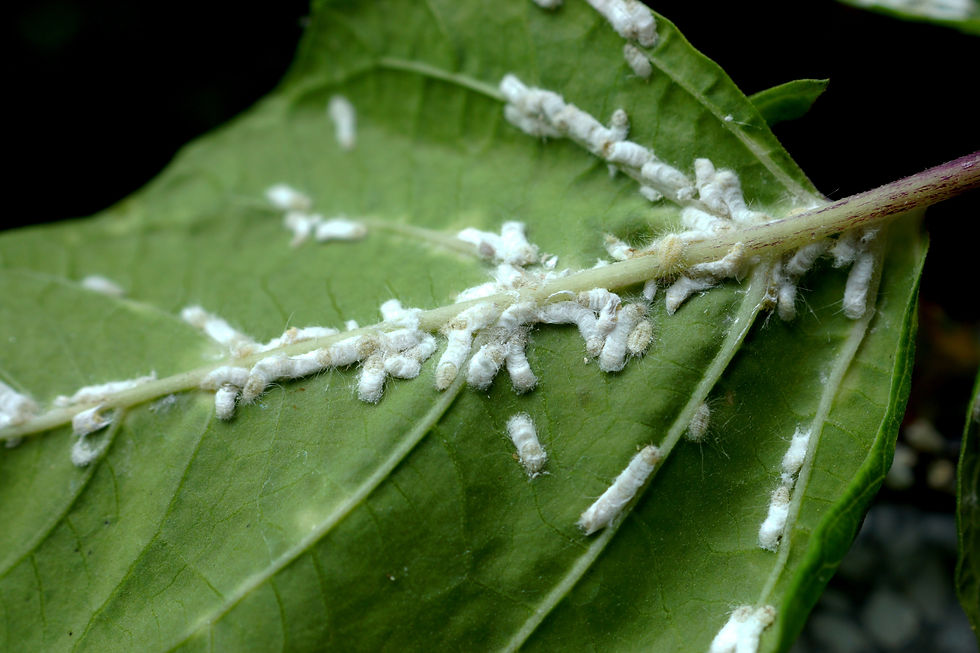Common pests in Indoor Plants and Ways to control them
- Hanafiee Azlee

- Oct 6, 2021
- 4 min read
Updated: Jul 6, 2022
Okay, so many of you guys are aware of pests. Those nasty small critters that would usually loiter around your mini garden or your plants. Those guys are so small that they can often be found on the underside of the leaves, in between the stems, on the soils or even inside the growing media. Given the right condition, such as light, temperature and moisture, they would multiply like crazy! Infesting all of your prized plants. If you are lucky, you can easily flick them away, but they usually come in a package, feeding off the vegetations you are growing. They could be as small as a speck of dust or as huge as a fly. I will briefly describe them at the later part of the blog, so keep on reading to find out about the different types of houseplant pest that you can find around your plants environment and how to mitigate this issue!
An infestation could lead to severe other issues that could stunt the growth of plants. Some pests could bear a virus in them, which could spread inside the plant’s biological system. This could kill the plants if they are not getting the right treatment as soon as possible. Hence, it is ideal to know the type of pest you are dealing with and the control strategy
Here are some of the common houseplants you may find on your plants!
Aphids

Aphids are little, soft-bodied, pear-shaped insects that measure 1/8 inch in length. Green is their most common colour and consists of waxy coat that gives some aphids a fuzzy or powdery look. They can be found feeding on new growth or the undersides of leaves. They suck plant sap and excrete a sugary material, called honeydew, which makes leaves shiny and sticky. Sooty mold fungi may grow on the honeydew, producing unsightly dark splotches on the plant’s surfaces.
Spider Mites

Mites are more closely related to spiders. Since they are extremely small, plant damage is typically the first sign of their presence. One of the common signs of spider mite is the presence of silky cobwebs. Both spider mite adults and their immature forms damage plants by sucking plant sap. There will be light-colored speckling on the upper surface of leaves indicates damage, and the plant appears faded overall. If the mites are not controlled, the leaves will turn bronze or yellow, and the plant will die. Spider mites are more commonly found on houseplants that are kept indoors all year.
Mealybugs

Mealybugs are small, pale insects, related to scales. They are about ¼ inch long and they move very sluggishly. They are covered with white, waxy material, making them look cottony. Once the nymphs have hatched, they begin to feed on the plants. The wax on mealybugs helps repel pesticides and makes them somewhat difficult to control. They can be found on the underside of the leaves. Just like aphids, they suck plant sap and excrete sugary material that may cause sooty mold fungi.
Scales

Scales come in various forms and sizes. They range in size from 1/16 to ½-inch in diameter. They are usually found on stems and the undersides of leaves but may be found on upper surfaces as well. Scales feed by sucking plant sap. Like mealybugs, the soft scale insects excrete honeydew, which results in black sooty mold problems on foliage and stems.
Whiteflies

Whiteflies more closely related to scales, mealybugs, and aphids. They are very small about 1/8 inch long. They have a powdery white appearance and resemble tiny moths. Both the adults and their immature forms feed by sucking plant sap. The damage that they cause is similar to that caused by aphids. The infested plant may be stunted in growth. The leaves will turn yellow and die. They excrete honeydew, which makes leaves shiny and sticky and encourages the growth of sooty mold fungi. When plants that are infested with whiteflies are disturbed, the whiteflies flutter around for a while before settling again.
So, what are the control strategies?
If you manage to find a plant that is infested with critters that are mentioned above, quickly isolate them away from any other of your plants to prevent them from spreading any further. You can use a cotton swab dipped in rubbing alcohol to wipe off insects such as aphids and mealybugs. By spraying a sturdy plant with water, it will remove many pests as long as it is sprayed at the contacted areas. Repeated water sprays help control spider mites. I also encourage plant owners to seek for other natural material, such as neem oil spray, to help in controlling invasion of pest.
As they say, prevention is better than having a solution. It is nearly always easier to prevent a pest infestation than it is to eliminate one. Therefore, the best strategy to control insects and associated pests on houseplants is through prevention. The plants you have should be in its optimum condition as stressed plants are susceptible to pests. Before buying a new plant, you should check If there is any existing pests that are on the plants. You can also gently wipe your plants, every two to three weeks, with lukewarm water to discourage any pest infestations. Consistently inspect your plants to ensure that there is no sign of pest that are on your plants.
It is natural for plants to not survive pest attacks. Sometimes, things just don’t seem to be able to go our way and that is okay! Now that we are aware of the type of pests we can find within the plants and the ways to mitigate them, we are a little more prepared to face such situations.


Comments